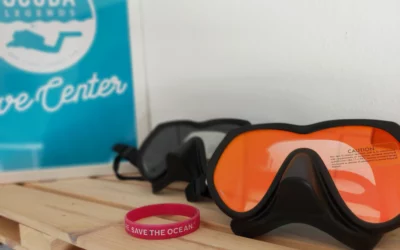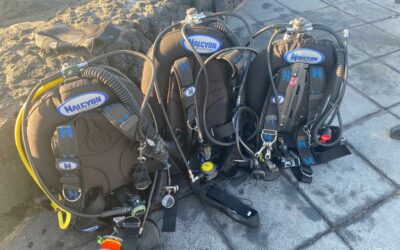There is a moment in the life of every diver when the word “cave” appears. Some divers say they will never practice cave diving. Others feel very excited about the subject and want to try it. Some claim to have dived in caves already. Caves are like the Mount Everest of diving, everyone talks about them, everyone looks up to cave divers and many pretend to be a cave diver. But what is cave diving? Why is it so remarkable?
Perhaps more than other forms of diving, in cave diving there is a real sense of exploration. You can dive on sites that have never been looked upon before and might never be visited again. Can you imagine this feeling? This can be one of the most addictive parts of cave diving.
Cave exploration is seemingly limitless, we don’t know at what point there is nothing left to discover.
If we were about to climb the Everest, we would know that once we have reached the top, the only way forward is to go back down. When diving a wreck, the limits of exploration are clearly defined. Cave systems instead can be so incredibly intricate and difficult to reach that we will never know exactly what’s there until we go and find out for ourselves.
Why to go cave diving?
When you talk about cave diving, the first thing that most people imagine is a narrow tunnel full of restrictions. Few people realize that diving in caves is also about visiting large chambers where the light of your torch does not reach either the ceiling or the bottom. You reach places where suddenly, in the midst of darkness, there appears a golden giant column. You might go through passages made of stalactites, stalagmites and columns that make you want to stay there forever admiring such wonders
Yet cave diving is growing in popularity and enticing people for all sorts reasons. Undoubtedly, some are drawn by the unique challenges posed by cave diving that can offer a great sense of accomplishment. The disciplined nature of cave diving is very appealing, and being part of an elite team can be highly rewarding.
Some of the Earth’s most breath-taking geological structures can only be found in caves. Enormous stalactites that may take several minutes to swim around, like The Fang in Mexico, or incredibly delicate formations of crystal such as those that decorate the caves of the Abaco Islands, Bahamas.
What is a cave?
Defining exactly what constitutes a cave usually varies depending on the required application. For the purposes of scuba diving, a cave is defined to acknowledge a specific set of associated hazards. A cave is any overhead environment that fulfils one or more of the following criteria:
– A complete absence of natural light or unable to see the exit
– An obligation to pass through a restriction (where two divers would be unable to pass side-by-side)
– A mandatory decompression stop
– More than 40m (130feet) from the surface/exit
By this definition, it is possible that environments not typically thought of as caves should be treated as such. This includes for example large wrecks, caverns or even mines. This is because the hazards presented by overhead environments are usually quite similar in nature.
What is a Cavern?
Many, too many times, we noticed the wrong use of the meaning of Cave Diving on social media or in diver’s conversations. The easiest example are the Cenotes in Mexico. Many people say “I went cave diving in Mexico!”. Usually I ask them if they visited the cenotes, and 99% of the cases the answer is “Yes”. Cenotes are caverns and yes, caverns are normally the beginning of a cave system. However, to dive in a cave is far different from diving in a cavern.Unlike the caves, the cavern area is the area where you can always see the exit, where you always have direct access to the surface and you do not have any restriction between you and the surface. In other words, it is the area where you can explore and come out without the need of full cave training.
“But wait, I went into the cave area, I did cave diving!”, answers the diver usually. Well, what you did was very bold. In addition, no, that was not cave diving. What you did is to put your life at risk in the most stupid way.
Getting started
To get into it Cavern training is highly recommend and can be your chance to see if you want to go further.To start cave diving it takes around 12-15 days of training. After that, you are able to call yourself an (inexperienced) cave diver. Cave diving is the most technical of Technical Diving.
You cannot just replace all that training with the hope that you might be lucky. Entering a cave without the right equipment, proper training, knowledge and the skills needed is extremely dangerous. Keep in mind that a mistake in a cave leads straight away into fatality.
Please, do not just dive into a cave because you think it is cool or interesting. There is nothing inside a cave worth of your life. If you are interested, do a course and gain experience.
What are good cave diver skills?
During a cave diving course skills such as gas planning and management, specialised fin techniques and redundancy planning. However, perhaps one of the most difficult skills to attain is the ability to do absolutely nothing.
Hovering at a maintained depth while holding a perfectly horizontal position, without even a flick or flinch of the fin, is one of the hardest skills to master.
In many ways, it is the foundation of all diving, and not just cave diving, but its value is more clearly apparent in an environment where it is not possible to freely ascend. In essence, this comprises good buoyancy control and it is crucial to be very competent before training.
The learning curve in a cave course, regardless of previous achievements, is usually high and combines a particularly satisfactory blend of challenge and accomplishment. Knowledge acquired and skills learnt are highly applicable to all forms of diving, including recreational diving. Reverse finning, for example, is a skill that is usually only taught during a technical course. However, it has just as much pertinence in many recreational dive scenarios, especially on safety stops where it is common for divers to slowly drift towards each other. A gentle reverse kick is usually sufficient to ensure adequate space between divers, while maintaining good buddy contact.
Cave diving locations
Caves can be found in almost all parts of the world. The most frequently dived ones are within karst regions. Regions where soluble rocks such as limestone or gypsum are found. Mexico’s Yucatan Peninsula is one such notable example, with barely a fraction of the underground rivers explored yet. Other famous cave diving locations include the Springs of Florida, especially Ginnie Springs, Hawaii, the Bahamas and Dahab in Egypt. Even Raja Ampat in Indonesia has its very own cave system, The Goa Farondi, that has barely been explored beyond the cavern zone and is only accessible by liveaboard.
Did you get excited? Come to visit Scuba Legends in Lanzarote and start your cavern adventure or combine it with some amazing wrecks.



